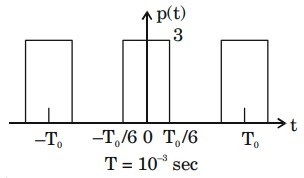21. In delta modulation, the slope overload distortion can be reduced by
22. Let x(t) = 2cos(800πt) + cos(1400πt).x(t) is sampled with the rectangular pulse train shown in the figure. The only spectral components (in kHz) present in the sampled signal in the frequency range 2.5 kHz to 3.5 kHz are


23. If Eb, the energy per bit of a binary digital signal, is 10-5 Watt-sec and the one-sided power spectral density of the white noise, N0 = 10-6 W/Hz, then the output SNR of the matched filter is
24. In a digital communication system employing Frequency Shift Keying (FSK), the 0 and 1 bit are represented by sine waves of 10 kHz and 25 kHz respectively. These waveforms will be orthogonal for a bit interval of
25. If the number of bits per sample in a PCM system is increased from a n to n + 1, the improvement in signal to quantization nose ratio will be
26. Flat top sampling of low pass signals
27. The input to a matched filter is given by
\[s\left( t \right) = \left\{ {\begin{array}{*{20}{c}}
{10\sin \left( {2\pi \times {{10}^6}} \right)}&{0 < t < {{10}^{ - 4}}\sec } \\
0&{{\text{Otherwise}}}
\end{array}} \right.\]
The peak amplitude of the filter output is
\[s\left( t \right) = \left\{ {\begin{array}{*{20}{c}} {10\sin \left( {2\pi \times {{10}^6}} \right)}&{0 < t < {{10}^{ - 4}}\sec } \\ 0&{{\text{Otherwise}}} \end{array}} \right.\]
The peak amplitude of the filter output is
28. At a given probability of error, binary coherent FSK is inferior to binary coherent PSK by
29. For a bit-rate of 8 Kbps, the best possible values of the transmitted frequencies in a coherent binary FSK system are
30. In the following figure the minimum value of the constant "C", which is to be added to y1(t) such that y1(t) and y2(t) are different, is


Read More Section(Digital Communication)
Each Section contains maximum 100 MCQs question on Digital Communication. To get more questions visit other sections.
